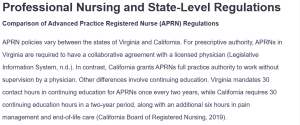Professional Nursing and State-Level Regulations
Comparison of Advanced Practice Registered Nurse (APRN) Regulations
APRN policies vary between the states of Virginia and California. For prescriptive authority, APRNs in Virginia are required to have a collaborative agreement with a licensed physician (Legislative Information System, n.d.). In contrast, California grants APRNs full practice authority to work without supervision by a physician. Other differences involve continuing education. Virginia mandates 30 contact hours in continuing education for APRNs once every two years, while California requires 30 continuing education hours in a two-year period, along with an additional six hours in pain management and end-of-life care (California Board of Registered Nursing, 2019).
Application to APRN Practice
These regulations have a significant effect on APRN practice. The requirement for a collaborative agreement in Virginia may inhibit APRNs from practicing to the full scope of their education, experience, and training, especially in underserved areas that may face limitations in the availability of physicians. In California, full practice authority could also accord APRNs latitude to give complete care without depending on others, a factor likely to result in increased access to health services.
Adherence to Regulations
In Virginia, APRNs must maintain a valid collaborative agreement with a licensed physician. This could include periodic meetings with the collaborating physician to discuss cases and current treatment plans, thereby keeping the physician updated and within the agreement terms.
APRNs participate in continuing education to satisfy state licensure renewal requirements through attendance at related conferences, workshops, and online courses. As a specific example, an APRN in Virginia might participate in a two-day conference in advanced pharmacology and obtain 16 contact hours toward their requirement of 30 hours (American Nurses Association, 2023; NCSBN, 2024). This protects both the professional promotion and state requirements regarding quality patient care.
References
American Nurses Association. (2023). American Nurses Association. ANA Enterprise. https://www.nursingworld.org/
California Board of Registered Nursing. (2019). Continuing education for license renewal. Ca.gov. https://www.rn.ca.gov/licensees/ce-renewal.shtml
Legislative Information System. (n.d.). Virginia Administrative Code | 18VAC90-40-90. Practice agreement. Legislative Information System – Virginia Law. https://law.lis.virginia.gov/admincode/title18/agency90/chapter40/section90/
NCSBN. (2024). National council of state boards of nursing. NCSBN. https://www.ncsbn.org/index.page
ORDER A PLAGIARISM-FREE PAPER HERE
We’ll write everything from scratch
Question 
Boards of Nursing (BONs) exist in all 50 states, the District of Columbia, American Samoa, Guam, the Northern Mariana Islands, and the Virgin Islands. Similar entities may also exist for different regions. The mission of BONs is the protection of the public through the regulation of nursing practice. BONs put into practice state/region regulations for nurses that, among other things, lay out the requirements for licensure and define the scope of nursing practice in that state/region.
It can be a valuable exercise to compare regulations among various state/regional boards of nursing. Doing so can help share insights that could be useful should there be future changes in a state/region. In addition, nurses may find the need to be licensed in multiple states or regions.
To Prepare:
- Review the Resources and reflect on the mission of state/regional boards of nursing as the protection of the public through the regulation of nursing practice.
- Consider how key regulations may impact nursing practice.
- Review key regulations for nursing practice of your state’s/region’s board of nursing and those of at least one other state/region and select at least two APRN regulations to focus on for this Discussion.
BY DAY 3 OF WEEK 5
- Post a comparison of at least two APRN board of nursing regulations in your state/region with those of at least one other state/region. Describe how they may differ. Be specific and provide examples. Then, explain how the regulations you selected may apply to Advanced Practice Registered Nurses (APRNs) who have legal authority to practice within the full scope of their education and experience. Provide at least one example of how APRNs may adhere to the two regulations you selected.

Professional Nursing and State-Level Regulations
Resources:
- Milstead, J. A., & Short, N. M. (2019). Health policy and politics: A nurse’s guide (6th ed.). Burlington, MA: Jones & Bartlett Learning.
- Chapter 4, “Government Response: Regulation” (pp. 57–84)
- http://www.nursingworld.org/
- Bosse, J., Simmonds, K., Hanson, C., Pulcini, J., Dunphy, L., Vanhook, P., & Poghosyan, L. (2017). Position statement: Full practice authority for advanced practice registered nurses is necessary to transform primary care. Nursing Outlook, 65(6), 761–765. doi:10.1016/j.outlook.2017.10.002
- https://www.ncsbn.org/index.htm